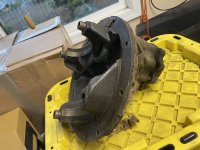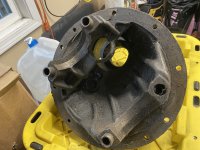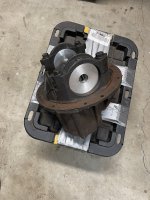I’m in for good tech too. Where are the metallurgists at
I'm not a metallurgist by trade, but have a LOT of steel fatigue and metallurgy education regarding my involvement in structural steel, along with all the "hobby" fabrication, gear work, etc over the years. I've also been involved in some pretty in depth projects regarding the mechanical rehab of some very large movable bridges with some pretty radically large gearing where the forces and wear become very evident over the years. Take all my comments with a grain of salt, as without seeing it in person I am just spitballing.
One of the pics of the failure, the adjacent ring teeth have some galling striations it appears. To me, this means the contact pattern, has been at times, less than an ideal module force (high point to high point in a rolling fashion) along the gear faces. When this occurs, it starts to "peel" at the tooth and not just apply shearing forces as it is intended to be loaded. So instead of it pushing the gear tooth straight, it kind of puts a shaving load as well as the shearing force, which if there is any stress riser (like the old pitting you mentioned) it will start to break open.
Another question I have, is how close is the ring to either the cover, or bottom of the housing? At any point could a hard rock smack possibly deformed the housing enough to tap the end of the gear teeth and shock the failure?
In comparison to the normal wear pattern, how is the failure located? Is the wear pattern more towards the outer edges of the ring gear teeth or deeper. Hows the pinion edges look also?
Theres also the chance that you've just beat the ever living Fawk out of something that is over 50 years old, and you found the point of fatigue. Pulling truck loads would seem to be more linear in application and less shock related than rock crawling your hawse ass truck in places like the Rubicon.
Edit:
Also, what's up with this? Looks like at some point the pinion was sliding off the edge of the ring? The thrust bolt adjusted correctly? How about the carrier bearings and the adjustment rings? I've put one of these together with the bearing race crooked and first hard reverse load knocked it back straight against the threaded collar and then the carrier was sloppy AF back and forth. You didn't kill a carrier bearing first and then these teeth were secondary victims?








